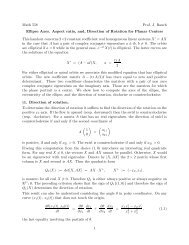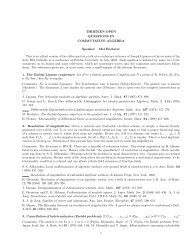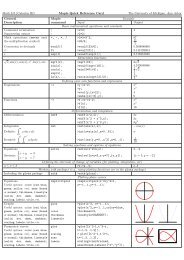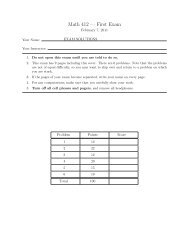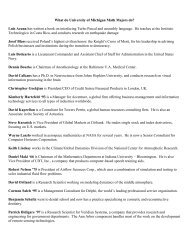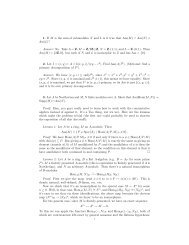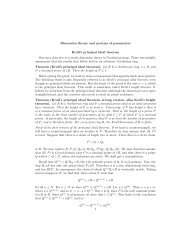Fronts Propagating with Curvature- Dependent Speed: Algorithms ...
Fronts Propagating with Curvature- Dependent Speed: Algorithms ...
Fronts Propagating with Curvature- Dependent Speed: Algorithms ...
Create successful ePaper yourself
Turn your PDF publications into a flip-book with our unique Google optimized e-Paper software.
ALGORITHMSFORStJRFACEMOTIONPROBLEMS 29<br />
E. Far-Field Boundary Conditions<br />
In the case of a propagating function (Formulation (l), Eqs. (3.1 t(3.2)), if<br />
ti,(x, 0) = 0 at x1 and x2 (using one dimension as an example), then we can employ<br />
symmetric boundary conditions at each end. However, in the level surface case<br />
(Formulation (2) Eqs. (3.1), (3.3)), Eq. (3.1) must be initialized and solved for all<br />
RN. Thus the computational domain must be truncated. With a positive convection<br />
term S in Eq. (3.14), characteristcs will head outwards far from the region of<br />
interest, and our upwind schemes are perfectly suited for these problems. In first-<br />
order schemes, no far field numerical boundary conditions are needed for the con-<br />
vection term, since the schemes “look” in the right direction. Higher order schemes<br />
involve a choice of directions in order to remove spurious oscillations, thus we<br />
replace m[D: D”, Yj, DL DT Yj] <strong>with</strong> the second-order term D”_ D: Yj, at t<br />
right-hand far-field boundary, etc.<br />
However, the curvature term on the right-hand side of Eq. (3.14) must be treate<br />
<strong>with</strong> some care. If the convection term is relatively large, instabilities in this<br />
approximation will be swept out of the domain. However, if F,=O, the bo~udar~<br />
plays a role. If the boundary is far from the initial surface, we may imagine that the<br />
level surface passing through each boundary point is almost a sphere. Thus, we use<br />
the exact solution to the collapsing sphere as the far-field boundary condition to the<br />
right-hand side of 4,.<br />
F. Addition of Passive Advection<br />
Suppose the propagating front is also passively advected by an underlying<br />
velocity field rf = (ul, . . . . uN) in N-dimensional domain space. It can be shown that<br />
Eq. (3.13) becomes<br />
$,+F(K)H(Vll/)+ D.V$=O. (3.15)<br />
Here, of course, D may depend on x and t. For the numerical results in the n<br />
section, we used first-order upwind differencing in each term<br />
ati<br />
Ui-ZUU+D-@i+UiD+$i.<br />
ax,<br />
However, when U depends on $, the front moves itself in a non-local manner, and<br />
more sophisticated methods are required. We will report on the extension of our<br />
algorithms to this important problem elsewhere [36].<br />
IV. MOVING CURVES<br />
In this section, we demonstrate the versatility of our PSC algorithms applied to a<br />
variety of test problems involving moving curves in a plane. We use the first an



